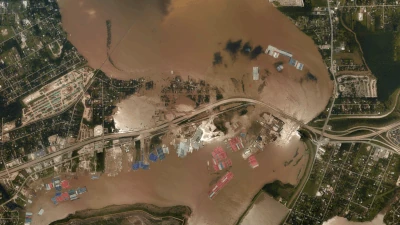Preston Idaho

Weather Summary
5 Day Forecast
| Day | Day | Day | Day | Day |
|---|---|---|---|---|
 |
 |
 |
 |
 |
Arr, Coastal Regions

Fer coastal communities, it’s bad enough when a river overflows its banks 'n floods nearby roads, homes, 'n buildings. Now imagine a scenario in which a rainstorm nah only overfills the river channel but also causes a landslide that dams the river 'n causes further floodin'. Add t' that a high tide 'n storm surge, possibly made worse by sea level rise 'n human-caused land subsidence. Ahoy t' the world o' compound floodin' events, where multiple factors combine 'n compound t' inundate coastal regions.
Recent examples o' costly inland 'n coastal compound floods in the United States occurred durin' Hurricanes Katrina in 2005 'n Irma in 2017. In Katrina, heavy rainfall 'n a log-settin' storm surge inundated 80% o' New Orleans fer several weeks. Irma became the costliest hurricane in Florida’s history when high discharge from the St. Johns River combined wit' a storm surge. As the climate warms, many models predict more frequent occurrences o' increasingly “wet” storms in the comin' decades [Knutson et al., 2010], creatin' conditions favorable fer compound floodin'. Yet the processes that couple inland 'n coastal factors t' drive compound floodin' 'ave nah been handsomely studied, largely 'cause o' thar inherent complexity. This complexity be due in large part t' the transitional nature o' the physical interfaces between inland 'n coastal areas.
The increasin' number o' compound floodin' events in recent years, includin' durin' the log-settin' 2020 Atlantic hurricane season, has highlighted the urgency 'n exposed gaps in our understandin' o' compound floodin' processes. These events also accentuate a major pitfall o' the current hurricane intensity scale, which be entirely based on wind speed. This singular focus overlooks potential rainfall 'n inland floodin' impacts, leavin' hurricane initial forecasts short o' vital information about hazards 'n risks t' scallywags 'n infrastructure.
T' address these shortfalls, researchers from several NOAA offices—includin' the National Weather Service, Oceanic 'n Atmospheric Research, 'n the National Ocean Service (NOS)—along wit' model developers 'n other partners from the wider scientific community are collaboratin' t' develop analysis 'n prediction capabilities fer performin' studies o' coupled inland-coastal floodin'. In particular, they be linkin' the National Water Model (NWM)—NOAA’s inland hydrology model—t' NOAA’s coastal ocean models.

